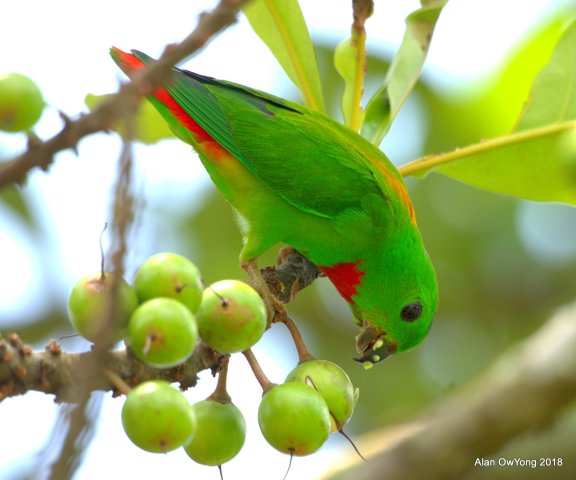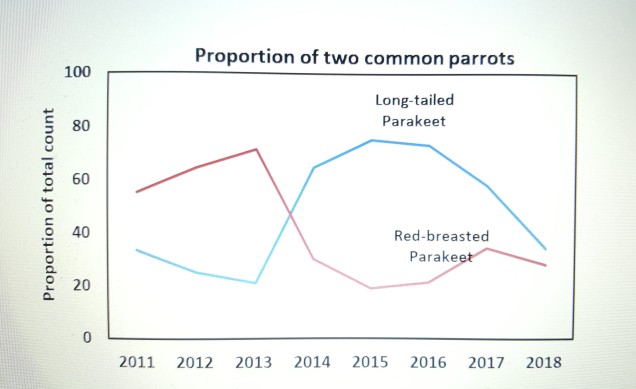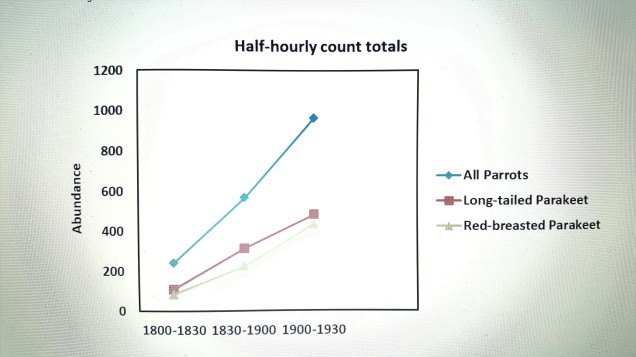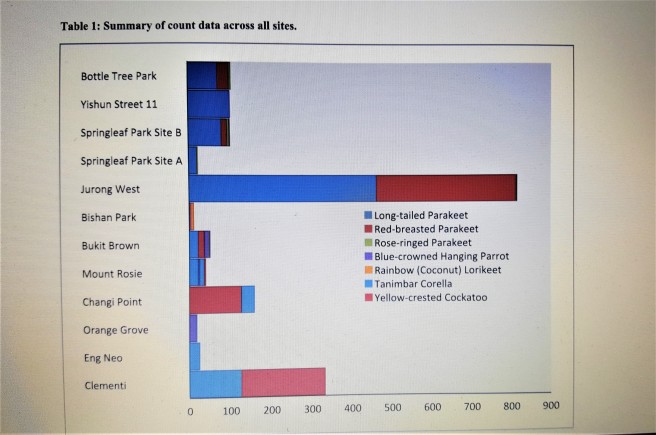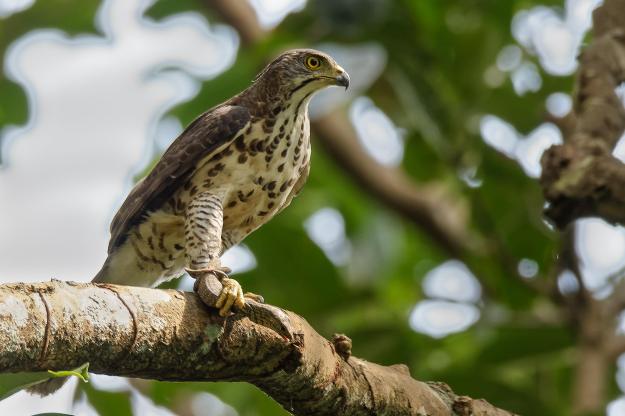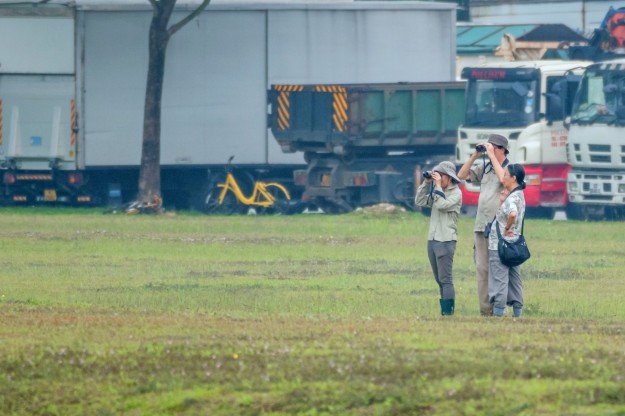The month of March yielded some spectacular surprises – an amazing vagrant that looks good to become Singapore’s first record of the Indian Paradise Flycatcher, a nesting Chestnut-bellied Malkoha pair in Jurong Eco-Garden (JEG) and a young Jerdon’s Baza that stayed at Bishan-Ang Mo Kio Park over one weekend. Migrants continue to be reported throughout the month.

Indian Paradise Flycatcher at SBWR on 23 March 2018, by Feroz Fizah.
A mixed report of resident and migratory species trickled into our consciousness during the first week of March. A Brown-chested Jungle Flycatcher Cyornis brunneatus was spotted on 1 March 2018 at the Singapore Botanic Gardens (SBG) by Nosherwan Sethna, while Alan Owyong was greeted by a Chestnut-winged Cuckoo Clamator coromandus when he crested the summit of Bukit Timah Hill; he earlier spotted a Drongo Cuckoo Surniculus lugubris while ascending the summit. Slightly further afield and on the same day, Martin Kennewell spotted an Orange-headed Thrush Geokichla citrina, Sunda Scops Owl Otus lempiji and Violet Cuckoo Chrysococcyx xanthorhynchus along Dairy Farm Loop.
The first Saturday of the month (3 March) yielded a migratory Von Schrenck’s Bittern Ixobrychus eurhythmus at Lower Pierce Reservoir (Vincent Lao), and a Chestnut-bellied Malkoha Phaenicophaeus sumatranus pair nesting along a public pathway at the Jurong Eco-Garden (Anthony Nik), where the chick fledged subsequently on the 14th (Esther Ong). A joint NParks-NSS Bird Group survey of Pulau Ubin on Sunday (4 March) yielded 6 Cinereous Bulbuls Hemixos cinereus, among other regular Ubin species, such as the Blue-eared Kingfisher Alcedo meninting, Blue-winged Pitta Pitta moluccensis, Buffy Fish Owl Ketupa ketupu, Crow-billed Drongo Dicrurus annectans and Mangrove Pitta Pitta megarhyncha. The survey team also counted 33 Grey Herons Ardea cinerea that flew in a south-easterly direction to Ubin. Roger Boey, who was with the survey, photographed a Ruby-cheeked Sunbird Chalcoparia singalensis, a report currently pending acceptance by the Records Committee, while a Barred Eagle Owl Bubo sumatranus was spotted by Adrian Silas Tay and Jerold Tan on the island. Back on mainland Singapore, a Watercock Gallicrex cinerea was reported by Heather Goessel at Mimosa Walk.

One of the nesting pair of Chestnut-bellied Malkohas at Jurong Eco-Garden with a praying mantis on 8 March 2018, photo by Terence Tan.
More reports of migratory species were reported between the week spanning 5 and 11 March. A White Wagtail Motacilla alba leucopsis subspecies was spotted at Marina Barrage on 6 March by Dodotee Tee. A Hooded Pitta Pitta sordida was seen at SBG on 8 March by Geri Lim. Two different Ruddy Kingfishers Halcyon coromanda were spotted, one on 8 March at West Coast Park by Thio Hui Bing, and another on 10 March at Venus Loop by Lim Kim Chuah. Oliver Tan chanced upon a Green-backed Flycatcher Ficedula elisae on 9 March near Dillenia Hut in the Central Catchment Nature Reserve. A juvenile Jerdon’s Baza Aviceda jerdoni spent the weekend at Bishan, alternating between the Bishan-Ang Mo Kio Parks 1 & 2 between 10 and 12 March. Known for its sporadic appearance at Tampines Eco Green (TEG) and Pasir Ris Park, this Baza has eluded many birders and photographers alike. Hence, its appearance in the heart of the island proved to be a boon to the community. Feroz Fizah photographed an accipiter on 11 March at Tampines Eco Green, which was subsequently identified by Adrian Silas Tay and Lau Jiasheng as an Eurasian Sparrowhawk Accipiter nisus.

TThe juvenile Jerdon’s Baza that lingered at Bishan-Ang Mo Kio Park between 10 and 12 March 2018. Photo taken on 10 March 2018 by Arman AF.
Resident species encountered included Blue-eared Kingfisher Alcedo meninting within the Central Catchment Nature Reserve (CCNR) on 8 March by Francis Yap, and a Little Bronze Cuckoo Chrysococcyx minutillus at JEG by Terence Tan, Pacific Reef Egret Egretta sacra at West Coast Park on 10 March by Kozi Ichiyama, while Felix Wong highlighted the fledging of a Scarlet-backed Flowerpecker Dicaeum cruentatum early in the morning from a HDB flat in Choa Chu Kang. This is the second known and documented record of the flowerpecker nesting in an urban environment. The second chick fledged around noon on 11 March.
Between 12 to 18 March, we continued to receive reports of migratory species across Singapore. A Blue-winged Pitta Pitta moluccensis and Forest Wagtail Dendronanthus indicus were encountered by Alan Owyong at Venus Loop. Martin Kennewell chanced upon a Black-backed Kingfisher Ceyx erithaca in the CCNR on 13 March, while an Orange-headed Thrush Geokichla citrina was seen by Luke Milo Teo at Ulu Sembawang on the same day. A Brown-backed Needletail Hirundapus giganteus was spotted hawking over the skies of HortPark by Keita Sin on 15 March, while Tan Kok Hui chanced upon a Large Hawk Cuckoo Hierococcyx sparverioides on Coney Island on the same day. Other notable migrants were a Red-rumped Swallow Cecropis daurica seen by Fadzrun Adnan on 16 March over Seletar Aerospace, a Yellow-rumped Flycatcher Ficedula zanthopygia in Pulau Ubin by Lena Chow on 16 March, a Baillon’s Crake Porzana pusilla in Kranji Marshes on 17 March by Martin Kennewell, and two Japanese Sparrowhawks Accipiter gularis, one seen winging over Henderson Wave by Tay Kian Guan on 16 March and another at Bukit Timah Nature Reserve on 17 March by Francis Yap.
Resident species spotted during this week include a Buffy Fish Owl Ketupa ketupu along Ulu Pandan Canal on 16 March by Jason Humphries, Grey-rumped Treeswift Hemiprocne longipennis and Ruddy-breasted Crake at One-North Cresent, also on 16 March, by Alan Owyong, a Grey-headed Fish-eagle Haliaeetus ichthyaetus along Ulu Pandan Canal on 17 March by Mark Nelson Valino, a Barred Eagle Owl Bubo sumatranus during a night survey on Pulau Ubin, also on 17 March, by Francis Yap and Jacky Soh, and a Crested Serpent Eagle Spilornis cheela at Malcolm Park on 18 March by Lena Chow.

Barred Eagle Owl spotted during a night survey of Pulau Ubin on 17 March 2018. Photo by Francis Yap.
The week of 19 to 25 March proved to be fruitful in terms of bird reports in social media. KC Ling reported at least 20 Blue-crowned Hanging Parrots Loriculus galgulus feeding from a White Gutta or Nyatoh Tree at the Eco-Garden within SBG. Lim Kim Keang reported spotting two Mangrove Whistlers Pachycephala cinerea on Pulau Hantu on 21 March, while Alan Owyong reported a Grey-headed Fish Eagle Haliaeetus ichthyaetus at Bishan Park on 23 March. Also on 23 March, Lim Kim Chuah reported that a Spotted Wood Owl Strix seloputo chick had fallen out of its nest at Pasir Ris Park. The chick was subsequently rescued by ACRES and restored into a nearby tree in a makeshift nest. Keita Sin reported spotting two Spotted Wood Owl Strix seloputo adults with two chicks at Bidadari on 24 March.

Male Blue-crowned Hanging Parrot on a White Gutta tree at the Eco-Garden in the Singapore Botanic Gardens on 24 March 2018. Photo by Geoff Lim.
Reports of migratory species continued to filter in. A Black Kite Milvus migrans was photographed by Veronica Foo flying over Lorong Halus on 21 March, while two instances of Black-backed Kingfishers Ceyx erithaca entering residential areas were reported: an injured bird at Keppel Bay on 21 March, and another bird which spent the night in Kim Forrester’s kitchen after flying inside. It left on its own accord the next morning. Feroz Fizah sought ID help for a Paradise Flycatcher photographed on 23 March at SBWR and Dave Bakewell noticed that it looked different from the Amur & Blyth’s, identifying it as an out-of-range Indian Paradise Flycatcher Terpsiphone paradisi, a first for Singapore! (Oliver Tan realised that he had photographed a similar-looking paradise flycatcher at SBWR on 2 Dec 2017). The bird was seen again on the 25th by many birders. On 23 March, Henrietta Woo and Ong Ruici reported seeing a Brown-chested Jungle Flycatcher Cyornis brunneatus at SBG, while a Western Osprey Pandion haliaetus was seen fishing at Sungei Buloh Wetland Reserve (SBWR) and another at Springleaf Nature Park by Thana Sinnarthamby and Cheah Chen Poh, respectively. On 24 March, Keita Sin spotted a Grey Nightjar Caprimulgus jotaka at Bidadari, while Felix Wong spotted two Hooded Pittas standing metres apart in SBG. A Jerdon’s Baza Aviceda jerdoni spotted by Luke Milo Teo on 24 March at Ulu Sembawang proved to be a new extreme date for the species. An NParks survey on Pulau Ubin on 25 March yielded Grey Plovers Pluvialis squatarola, a Bar-tailed Godwit Limosa lapponica in breeding plumage and a Great Knot Calidris tenuirostris at Chek Jawa. Meanwhile, Doreen Ang, together with two friends, spotted a first winter Red-throated Pipit Anthus cervinus at Bulim on 25 March.

A Green-backed Flycatcher in the Central Catchment Nature Reserve on 29 March 2018, by Oliver Tan. The bird was video-recorded while singing.
The final week of March (26 – 31 March) yielded several interesting records. Two Green-backed Flycatchers Ficedula elisae were spotted, a calling female by Fadzrun Adnan on 27 March at Venus Loop, and a singing male by Oliver Tan inside CCNR. A Yellow-browed Warbler Phylloscopus inornatus was spotted at Bidadari by Martin Kennewell on 28 March. A White-shouldered Starling Sturnia sinensis was reported on Pulau Ubin on 29 March by Joseph Lin, a first for the island (correction: there was an earlier record on 8 Oct 2017 by Martin Kennewell). Migratory flycatchers continue to be reported – a Yellow-rumped Flycatcher Ficedula zanthopygia at Kheam Hock Road on 29 March by Thana Sinnathamby, and a Ferruginous Flycatcher Muscicapa ferruginea at Ulu Sembawang by Luke Milo Teo on 30 March.

The highly prized Band-bellied Crake continued to be seen at the Singapore Botanic Gardens on 31 March 2018. Photo taken by Geoff Lim.
Two Peregrine Falcons Falco peregrinus were recorded, one at SBWR on 30 March by Tan Kok Hui, and another at Fairway Golf Course on 31 March by Alan Owyong. A Northern Boobook Ninox japonica was reported at a Pasir Ris HDB block on 31 March by Ryan Lee, while an Eastern-crowned Warbler Phylloscopus coronatus was seen inside CCNR by Martin Kennewell. Also spotted on 31 March was the Band-bellied Crake Porzana paykullii by Geoff Lim, Kozi Ichiyama and visiting Australian birder, Alastair White, at SBG. The highlight of the last day of March would be the Indian Paradise Flycatcher relocated at SBWR by Lim Kim Chuah.
Residents reported during this week include an injured Eastern Barn Owl Tyto delicatula at Jurong West Street 91 by Hafinani on 28 March, an Abbott’s Babbler Malacocincla abbotti at West Coast Park on 29 March by Art Toh, a Plaintive Cuckoo Cacomantis merulinus at SBWR on 30 March by Tan Kok Hui, a Van Hasselt’s Sunbird Leptocoma brasiliana at Ulu Sembawang on the same day by Luke Milo Teo, and a Red-crowned Barbet Megalaima rafflesii on 31 March inside CCNR by Martin Kennewell.
During their pelagic trip along the multi-national Straits of Singapore on 3 March, Francis Yap, Seetoh Yew Wai and friends spotted a Parasitic Jaegar Stercorarius parasiticus, as well as Lesser Crested Tern Thalasseus bengalensis, Swift Tern Thalasseus bergii, and a Pacific Reef Egret Egretta sacra. Note that some of these may not be in Singapore waters.

Parasitic Jaegar in flight during the pelagic trip on 3 March 2018, by Francis Yap.
Abbreviations:
BTNR: Bukit Timah Nature Reserve
CCNR: Central Catchment Nature Reserve
JEG: Jurong Eco-Garden
SBG: Singapore Botanic Gardens
SBWR: Sungei Buloh Wetland Reserve
TEG: Tampines Eco-Green
This report is compiled by Geoff Lim and Alan OwYong, edited by Tan Gim Cheong, based on selected postings in various facebook birding pages, bird forums, individual reports and extracts from ebird. This compilation is not a complete list of birds recorded for the month and not all the records were verified. We wish to thank all the contributors for their records. Many thanks to Feroz Fizah, Terence Tan, Arman AF, Oliver Tan, Geoff Lim and Francis Yap for the use of their photos.





